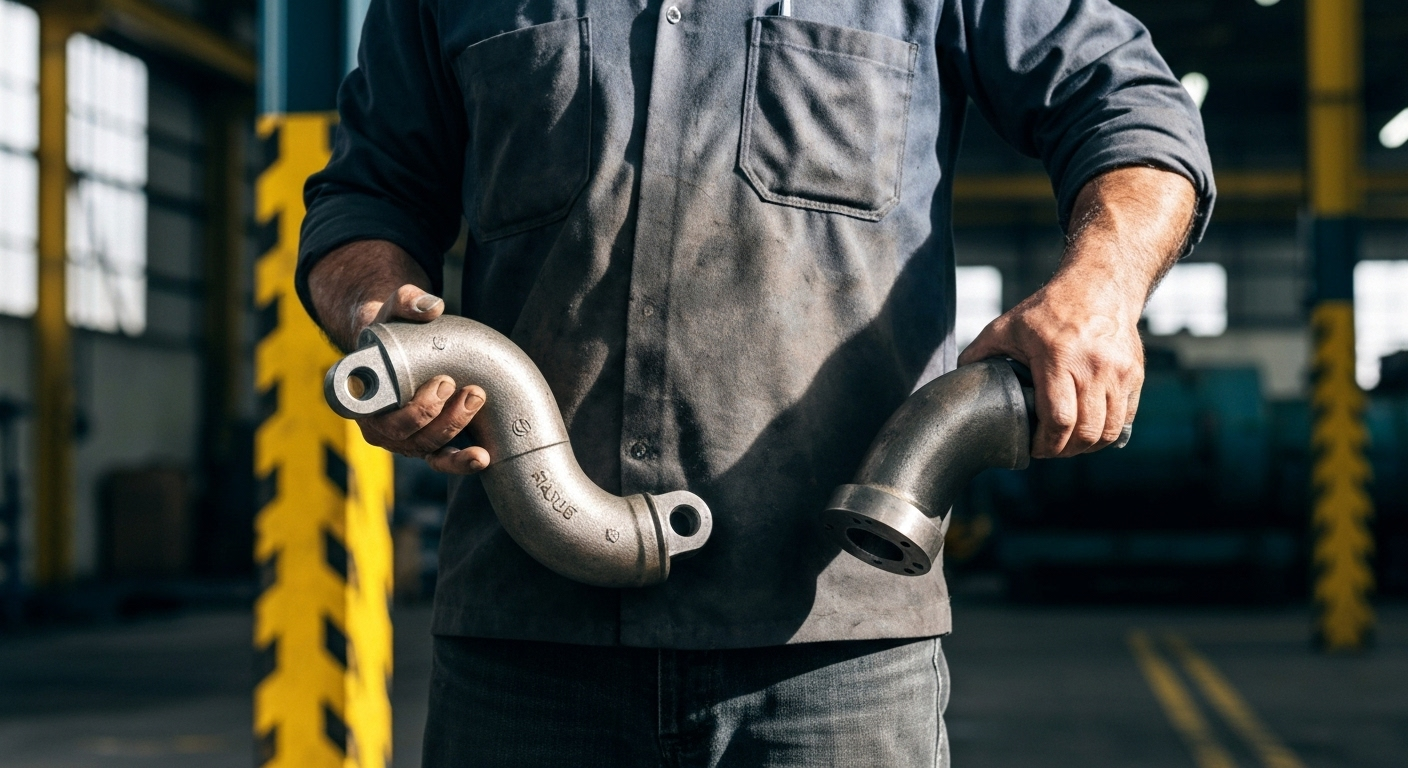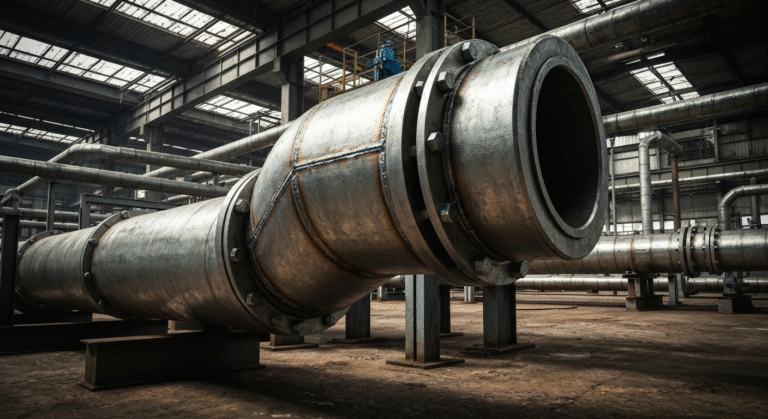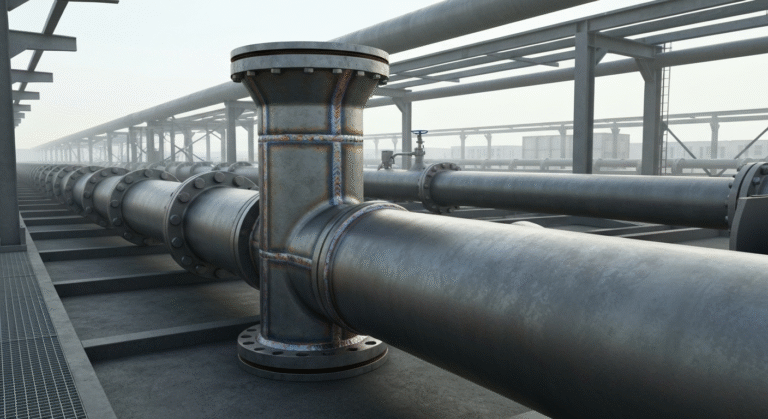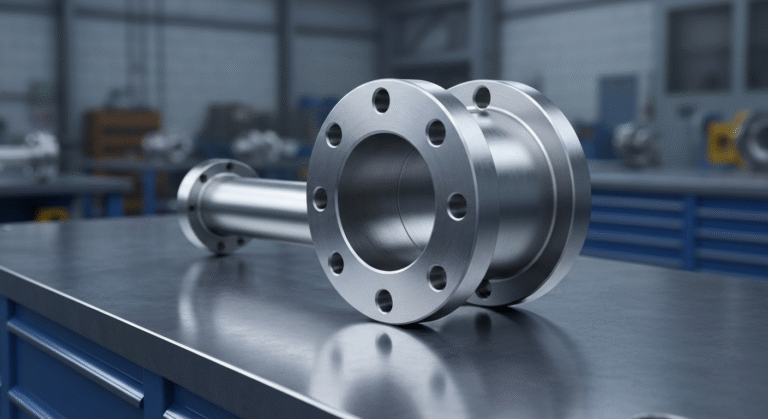-
Промышленная зона Иньчжуан, уезд Мэнцюнь, город Цанчжоу, провинция Хэбэй, Китай

Сравнение типов колен A234 WPB: Длинный и короткий радиус

Основные моменты
Here is a quick look at the main points of our comparison:
- A 90-degree elbow is a crucial pipe fitting used to change the direction of flow by 90 degrees in a piping system.
- The primary difference between a long radius (LR) and short radius (SR) elbow is the curve’s radius; LR is 1.5 times the pipe diameter, while SR is equal to the pipe diameter.
- ASTM A234 WPB is a standard specification for wrought carbon and alloy steel pipe fittings designed for moderate and high-temperature service.
Long radius elbows provide smoother flow and less pressure drop, making them ideal for systems prioritizing efficiency.
You can purchase 90 degree pipe elbows, including long radius elbow and other steel pipe fittings, from authorized industrial supply distributors, online retailers specializing in plumbing and pipe fitting products, and dedicated stores that carry alloy steel fittings conforming to astm standards for both home and industrial applications.
- Long radius elbows provide smoother flow and less pressure drop, making them ideal for systems prioritizing efficiency.
- Short radius elbows are more compact, fitting into tight spaces where flow resistance is a secondary concern.
- Choosing the correct elbow type depends on your system’s specific needs for space and flow performance.
Введение
When you design a piping or plumbing system, you often need to change the flow’s direction. Pipe fittings help with this, and elbows are one of the main parts that do this job. A 90-degree elbow is very common because it lets the flow turn at a right angle. But, there are not only one kind of this degree elbow to use. There are two main kinds: long radius and short radius, with options available in materials like brass. It is important to know the difference between these two types. This helps be sure your piping system works well and will fit in the space you have. In this guide, we will look at both important elbows and see how they compare. If you are looking to buy 90 degree pipe elbows for home or industrial use, you can find them at local hardware stores, specialized plumbing supply shops, or through online retailers that sell pipe fittings. There are many options available depending on the material and specification you need for your piping system.
Overview of ASTM A234 WPB Elbows

The ASTM A234 WPB is a standard specification used for quality and performance of some pipe fittings. This astm covers carbon steel and alloy steel fittings. You often find these in systems where there is pressure and the temperature is not low. This standard makes sure that steel pipe elbows and fittings you use are made well and from the right material. You can trust that these pipe fittings will do the job for you in most working situations.
The “WPB” tells more about the pipe fittings. “W” means the fitting is “wrought.” This says that the steel is bent or shaped, not cast. “P” shows it is built to be used in piping with pressure. “B” means it matches Grade B material and the lowest yield strength found in most steel pipe grades. Knowing about these specifications helps you get the right parts for your piping work. Next, we will look more into the main materials and standards, like carbon steel and alloy steel, to see what makes them good choices for strong piping.
Characteristics and Common Materials Used
ASTM A234 WPB elbows are made mainly of carbon steel. This makes them a top choice for many piping jobs in different industries. They are strong and long-lasting, so people use them in oil and gas pipelines, power plants, and chemical factories. These fittings are usually made by forging or stamping, which helps make the product very solid and good for everyday use.
The WPB grade is the name for carbon steel in this group. But the wider ASTM A234 specifications also cover fitting types made from alloy steel. These could be grades like WP1, WP5, WP9, WP11, and WP91. You use those when you need to handle higher heat or more pressure. This choice helps you find the right type of alloy steel or carbon steel fitting for your pipelines or any work you have.
You should also know that fittings and elbows, including a tee, are not just made of carbon steel or alloy steel. For some piping or plumbing jobs, you may want a stainless steel fitting that fights rust better, or even PVC, which people often use in lower pressure pipes. So, you can get a 90-degree elbow in carbon steel, stainless steel, or even PVC. But each one of these will follow its own specifications, so always look at that before you choose any fitting for your pipelines or piping work.
Standard Specifications for 90 Degree Elbows
Yes, there are some standard specifications you have to follow when making 90-degree elbows. These rules help keep things safe and the same each time. In North America, the main one is ASME B16.9. This covers factory-made wrought buttwelding pipe fittings. It tells you the right sizes, the allowed difference in sizes, and what marks should be put on fittings like an ASTM A234 WPB elbow. Other places use rules such as MSS SP-43, JIS, and EN10253 (these are Japanese and European standards).
A 90-degree elbow for pipe fittings is just a part used to connect two steel pipes. These can have the same or different diameter, and the socket weld elbow joins them at a 90-degree angle. This helps redirect where gases or fluids go inside your piping system. People use these steel pipe fittings a lot when they need to go around something or make a neat pipeline shape.
These standard specifications give rules for many sizes, covering elbows from 1/2-inch up to 80-inch in diameter. They also have the wall thickness options, called “schedule.” The most common are SCH 40, SCH 80, and SCH 160 thickness. When you use a well-known standard specification like ASME B16.9, this lets you be sure the steel pipe elbow will fit right onto your pipe and stand up to what your system needs.
Long Radius vs. Short Radius: Key Design Differences
The biggest design change between a long radius elbow (LR) and a short radius elbow (SR) is the curve’s radius. A long radius elbow has a bend that goes out 1.5 times the pipe’s size (1.5D). A short radius elbow has a curve that matches the pipe’s size (1D).
This small change in radius can make a big difference. The LR fitting has a smoother curve. That helps the fluid move with less push-back, so there is less flow resistance. The SR elbow, with its tighter turn, takes up less space, so you can use it when there is not much room to work with. If you want to see how these long radius and short radius parts work in a pipe system, you can look at both the measurements and how they affect things like movement of the liquid or air inside.
Dimensions and Physical Properties Comparison
The primary dimensional difference between LR and SR elbows is the center-to-end measurement. Because a long radius elbow has a wider sweep, its center-to-end dimension is greater than that of a short radius elbow of the same diameter and wall thickness. This is a critical factor when planning your piping layout, as it directly affects how much space the turn will occupy.
For example, an SR elbow offers a more compact fitting for routing pipe in confined spaces. The physical properties, such as material strength and pressure rating, are determined by the ASTM grade and schedule (wall thickness), not by the radius type. Selecting the correct size involves matching the elbow’s nominal pipe size (NPS), outside diameter, and schedule to the connecting pipe.
The table below illustrates the difference in the center-to-end dimension (A) for a few common sizes according to the ASME B16.9 standard.
Номинальный размер трубы (NPS) | Outside Diameter (OD) in mm | Center-to-End LR (A) in mm | Center-to-End SR (A) in mm |
|---|---|---|---|
2″ | 60.3 | 76 | 51 |
4″ | 114.3 | 152 | 102 |
6″ | 168.3 | 229 | 152 |
10″ | 273.0 | 381 | 254 |
Impact on Flow and Pressure in Piping Systems
The choice between a long radius and a short radius elbow has a big effect on how fluids move in your piping system. A long radius elbow gives the flow a smoother and more gentle turn. This easier path helps cut down on turbulence, friction, and pressure drop. When should you pick a long radius 90 degree elbow instead of a short radius one? You should use it when you want to keep flow working well and reduce pressure loss.
But a short radius elbow has a sharper turn. This creates more resistance and a bigger pressure drop. The extra turbulence can also cause erosion and corrosion to happen faster. This is a bigger problem in pipelines that use rough fluids or run at high speeds. Because of this, people usually try not to use short radius elbows where flow is important.
In the end, when you pick between these options, you need to balance performance with the room you have. If your piping or pipelines have enough space for the bigger size of a long radius elbow, it is almost always better for flow. Short radius elbows are only used if you don’t have much space and you can allow for more pressure drop.
Choosing Between Long Radius and Short Radius Elbows
Choosing between long radius elbows and short radius elbows depends on what you need for your job. You have to think about space and how well the system moves liquids. If you want to keep pressure loss as low as possible, you might need a long radius elbow. If your steel pipe system is packed into a small space, you might go with a short radius elbow instead.
You need to know what is most important for you. Most plumbing and factory systems use long radius elbows because they help the flow. But if you do not have enough space, a short radius elbow works better.
Let’s look at some real-life uses. There are other things that can help you figure out which radius elbow you should choose.
Application Scenarios in Plumbing and Industry
The way these elbows are used can be very different in plumbing and big industry jobs. Most of the time, you want to keep flow steady and not lose pressure in the system. Long radius elbows help with this. They are the best pick for many big steel pipe pipelines.
Long radius elbows have a smooth inside. This lowers friction, so fluids can move easier over long stretches of pipe. That is why they are always needed in jobs that use a lot of steel pipe. They help move slurries and thick fluids too. Because they do not wear out fast, people count on them for these jobs.
Here are common uses for 90-degree elbows:
- Длинный радиус (LR): Good in oil and gas pipelines, water treatment, water system works, low-pressure plumbing, and power plants. These places all need high flow with less pressure loss.
- Короткий радиус (SR): Used in places with high pressure or high heat, where things need to fit in small spaces, in skid-mounted jobs, or in plumbing when saving space matters more than less pressure loss.
Factors Affecting Selection and Installation
When you pick a 90-degree elbow, you have to think about more than just the radius. The first thing to do is to choose the size that matches. The fitting needs to have the same nominal diameter and wall thickness as the pipe you use. The right thickness, called the schedule, keeps the flow good and the system strong. If you choose the wrong schedule, you may get less flow. The system could also be weak.
The way you install it matters too. ASTM A234 WPB elbows are butt weld type fittings. To install a butt weld fitting, you need to put the beveled ends of the elbow and pipe together. Next, you weld them to make one piece that is strong and does not leak. This clean joint stays tight and lasts a long time. This is the usual way for jobs that need high pressure and temperature. In those cases, you really need good joints.
Think about the fluid you move, the pressure inside, and the temperature. These things help you choose the grade for the carbon steel or alloy steel. For some jobs, you want a standard WPB grade. Other jobs may need a high-yield steel or alloy steel grade. Always look up the industry standards and codes for piping. That way, your fitting, wall thickness, and installation are up to the mark and will keep people and equipment safe.
Заключение
To sum up, knowing the differences between long radius and short radius ASTM A234 WPB elbows matters a lot when you are working on piping design or putting in a new system. Each has its own traits that can change how flow, pressure, and your whole system work. Take time to look at what your project needs, like where you will use it and how it will be installed. That will help you pick the type of elbow that fits best. Making the right choice can make your system work better and last longer. If you have questions about which elbow to pick or how to install it, you can always talk to industry experts.
Часто задаваемые вопросы
When should I use a long radius 90 degree elbow instead of a short radius one?
You should pick a long radius (LR) elbow if you want smooth flow and less pressure drop. Go for a short radius (SR) elbow only when you do not have much space and you are okay with more pressure loss in your system.
Are ASTM A234 WPB elbows available in both carbon steel and stainless steel?
The ASTM A234 WPB specifications are made for wrought carbon and alloy steel fittings. You will find that 90-degree elbows in stainless steel are common. But they be made and graded based on different ASTM specifications. For stainless steel fittings, ASTM A403 is often used, not WPB.
How do I select the correct size of 90 degree elbow for my piping system?
To pick the right size, you have to check the pipe size, its outside diameter, and its wall thickness before you connect the fitting to the pipe. Always look at the ASME B16.9 rules to be sure the fitting is good and has the needed thickness and diameter for your work. This will help all the parts fit the way they should.


